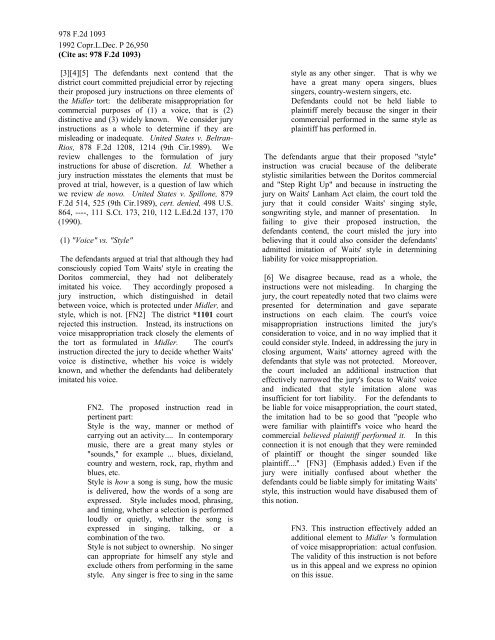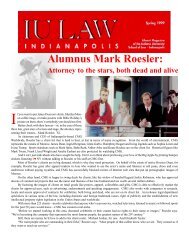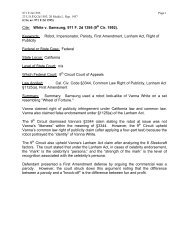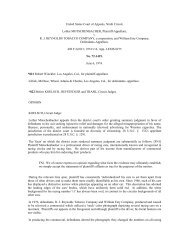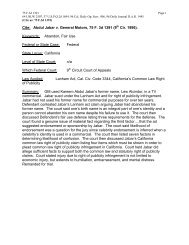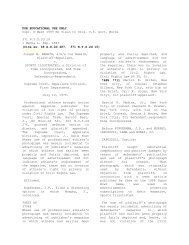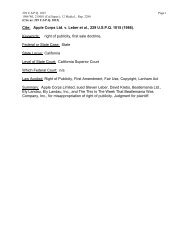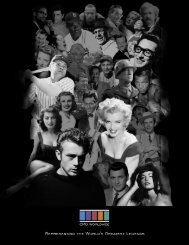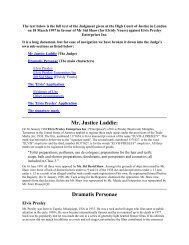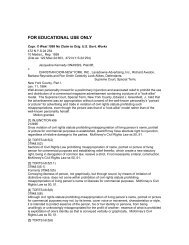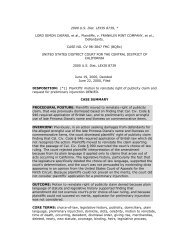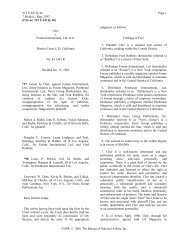Cite: Waits v. Frito Lay, 978 F. 2d 1093 (9th Cir. 1992 ... - Mark Roesler
Cite: Waits v. Frito Lay, 978 F. 2d 1093 (9th Cir. 1992 ... - Mark Roesler
Cite: Waits v. Frito Lay, 978 F. 2d 1093 (9th Cir. 1992 ... - Mark Roesler
You also want an ePaper? Increase the reach of your titles
YUMPU automatically turns print PDFs into web optimized ePapers that Google loves.
<strong>978</strong> F.<strong>2d</strong> <strong>1093</strong><br />
<strong>1992</strong> Copr.L.Dec. P 26,950<br />
(<strong>Cite</strong> as: <strong>978</strong> F.<strong>2d</strong> <strong>1093</strong>)<br />
[3][4][5] The defendants next contend that the<br />
district court committed prejudicial error by rejecting<br />
their proposed jury instructions on three elements of<br />
the Midler tort: the deliberate misappropriation for<br />
commercial purposes of (1) a voice, that is (2)<br />
distinctive and (3) widely known. We consider jury<br />
instructions as a whole to determine if they are<br />
misleading or inadequate. United States v. Beltran-<br />
Rios, 878 F.<strong>2d</strong> 1208, 1214 (<strong>9th</strong> <strong>Cir</strong>.1989). We<br />
review challenges to the formulation of jury<br />
instructions for abuse of discretion. Id. Whether a<br />
jury instruction misstates the elements that must be<br />
proved at trial, however, is a question of law which<br />
we review de novo. United States v. Spillone, 879<br />
F.<strong>2d</strong> 514, 525 (<strong>9th</strong> <strong>Cir</strong>.1989), cert. denied, 498 U.S.<br />
864, ----, 111 S.Ct. 173, 210, 112 L.Ed.<strong>2d</strong> 137, 170<br />
(1990).<br />
(1) "Voice" vs. "Style"<br />
The defendants argued at trial that although they had<br />
consciously copied Tom <strong>Waits</strong>' style in creating the<br />
Doritos commercial, they had not deliberately<br />
imitated his voice. They accordingly proposed a<br />
jury instruction, which distinguished in detail<br />
between voice, which is protected under Midler, and<br />
style, which is not. [FN2] The district *1101 court<br />
rejected this instruction. Instead, its instructions on<br />
voice misappropriation track closely the elements of<br />
the tort as formulated in Midler. The court's<br />
instruction directed the jury to decide whether <strong>Waits</strong>'<br />
voice is distinctive, whether his voice is widely<br />
known, and whether the defendants had deliberately<br />
imitated his voice.<br />
FN2. The proposed instruction read in<br />
pertinent part:<br />
Style is the way, manner or method of<br />
carrying out an activity.... In contemporary<br />
music, there are a great many styles or<br />
"sounds," for example ... blues, dixieland,<br />
country and western, rock, rap, rhythm and<br />
blues, etc.<br />
Style is how a song is sung, how the music<br />
is delivered, how the words of a song are<br />
expressed. Style includes mood, phrasing,<br />
and timing, whether a selection is performed<br />
loudly or quietly, whether the song is<br />
expressed in singing, talking, or a<br />
combination of the two.<br />
Style is not subject to ownership. No singer<br />
can appropriate for himself any style and<br />
exclude others from performing in the same<br />
style. Any singer is free to sing in the same<br />
style as any other singer. That is why we<br />
have a great many opera singers, blues<br />
singers, country-western singers, etc.<br />
Defendants could not be held liable to<br />
plaintiff merely because the singer in their<br />
commercial performed in the same style as<br />
plaintiff has performed in.<br />
The defendants argue that their proposed "style"<br />
instruction was crucial because of the deliberate<br />
stylistic similarities between the Doritos commercial<br />
and "Step Right Up" and because in instructing the<br />
jury on <strong>Waits</strong>' Lanham Act claim, the court told the<br />
jury that it could consider <strong>Waits</strong>' singing style,<br />
songwriting style, and manner of presentation. In<br />
failing to give their proposed instruction, the<br />
defendants contend, the court misled the jury into<br />
believing that it could also consider the defendants'<br />
admitted imitation of <strong>Waits</strong>' style in determining<br />
liability for voice misappropriation.<br />
[6] We disagree because, read as a whole, the<br />
instructions were not misleading. In charging the<br />
jury, the court repeatedly noted that two claims were<br />
presented for determination and gave separate<br />
instructions on each claim. The court's voice<br />
misappropriation instructions limited the jury's<br />
consideration to voice, and in no way implied that it<br />
could consider style. Indeed, in addressing the jury in<br />
closing argument, <strong>Waits</strong>' attorney agreed with the<br />
defendants that style was not protected. Moreover,<br />
the court included an additional instruction that<br />
effectively narrowed the jury's focus to <strong>Waits</strong>' voice<br />
and indicated that style imitation alone was<br />
insufficient for tort liability. For the defendants to<br />
be liable for voice misappropriation, the court stated,<br />
the imitation had to be so good that "people who<br />
were familiar with plaintiff's voice who heard the<br />
commercial believed plaintiff performed it. In this<br />
connection it is not enough that they were reminded<br />
of plaintiff or thought the singer sounded like<br />
plaintiff...." [FN3] (Emphasis added.) Even if the<br />
jury were initially confused about whether the<br />
defendants could be liable simply for imitating <strong>Waits</strong>'<br />
style, this instruction would have disabused them of<br />
this notion.<br />
FN3. This instruction effectively added an<br />
additional element to Midler 's formulation<br />
of voice misappropriation: actual confusion.<br />
The validity of this instruction is not before<br />
us in this appeal and we express no opinion<br />
on this issue.


